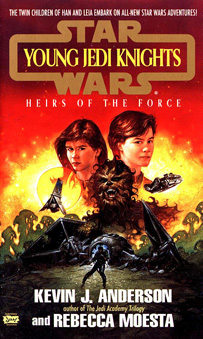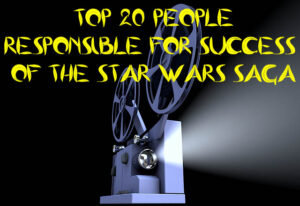On the heels of the excellent “Clone Wars” four-parter featuring younglings Byph, Gungi, Ganodi, Zatt, Petro and Katooni, I decided to finally dive into Kevin J. Anderson and Rebecca Moesta’s 14-book “Young Jedi Knights” series that ran from 1995-98. I had read the first couple books when they came out, then abandoned the series to focus on comics and adult novels. But I always maintained a low-level curiosity about them, due largely to the gorgeous Dave Dorman cover art that portrays Jacen, Jaina and friends at various famous “Star Wars” locales like Yavin, Kessel, Mon Calamari and Ord Mantell.
Although not as much of a slog as when I finally read the “Ewoks” and “Droids” comics last year, the “Young Jedi Knights” series, from an adult perspective, suffers from being written for kids. In an interview with the Star Wars Book Report podcast, Anderson claimed that he (and his wife, Moesta, with whom he traded off chapters) wrote these books the same way he writes anything; they only came off as “young adult” because the main characters were teenagers dealing with teenage issues. But I disagree. Anderson has written some respectable adult stuff — his four adult “Star Wars” novels are good reads, especially “Darksaber,” and his comic series “Tales of the Jedi: Redemption” is one of the best “Star Wars” yarns, period. “Young Jedi Knights” doesn’t have the same emotional complexity. The writing style on these 14 novels is straight-ahead, not nuanced or layered, and basically aimed at kids who are just catching the reading bug.
Part of my disappointment stems from being spoiled by the “Harry Potter” series. Although fairly labeled “young adult,” I enjoyed those books as an adult because of J.K. Rowling’s imaginative universe and the cute relationships and personalities of the characters. The recent “Clone Wars” arc likewise features youngsters who pop off the screen with their distinct traits and problems. “Young Jedi Knights” is comparatively clunky. Jacen is good with animals and tells bad jokes. Tenel Ka is an athletic warrior girl. Jaina’s good at repairing ships. A character from the final three books, Anja Gallandro, is a spice addict who is secretly plotting against our heroes. These initial characterizations are juicy enough, but there’s no development — everyone stays within their mold. It’s clear enough what the romantic relationships are — Jacen and Tenel Ka, Jaina and Zekk, Raynar and Lusa — but they don’t develop, either.
I don’t doubt that young readers will like these books, though. In a broad sense, they feel like “Star Wars.” The Jedi Academy on Yavin 4 is a comfortable home base, and it’s just plain fun to travel to the different “Star Wars” planets and sometimes get cameos such as Lando, Luke, Han and Nien Nunb. Anderson and Moesta sometimes draw upon previous novels, which is neat. My favorite example is in “Return to Ord Mantell” when the authors recount Han’s adventures on the planet, detailing the events from the Goodwin and Williamson newspaper strip (collected by Dark Horse in “Classic Star Wars”) and Brian Daley’s record “Rebel Mission to Ord Mantell.” Soon after that, we meet Anja Gallandro, who believes Han killed her dad, a reference to Daley’s “Han Solo’s Revenge.”
When I was a kid, I devoured every “Hardy Boys” book that was printed, but if I were to try reading them now, I’d no doubt be shocked by the shallow characterizations and simple plots. Because I read the adult novels “Heir to the Empire” and “Jurassic Park” in the early 1990s, when I was in my early teens, I basically skipped from “Hardy Boys” to adult novels and never delved into the young-adult thing, except for trying a couple books in the “Young Jedi Knights” series before deciding they were a bit shallow for me.
It turns out that I had the right idea 20 years ago. Certainly, Anderson’s and Moesta’s series is just fine for kids — I’d say tweens, roughly, although it depends on the individual youth’s reading level. But unlike “Harry Potter,” there’s no crossover here, and adult fans can rest assured that they aren’t missing much by skipping this series. All of the series’ major characters feature in the “New Jedi Order” and beyond, but there’s just not enough compelling backstory here to make the “Young Jedi Knights” series into an essential read.
A couple of additional notes:
- Anakin Solo and Tahiri Veila aren’t main characters in “Young Jedi Knights.” Anakin appears a few times, and Tahiri only once. They get more to do in the “Junior Jedi Knights” series, aimed at even younger readers.
- Luke and Mara are married throughout “Young Jedi Knights,” but it’s never mentioned in the narrative. This is because although Zahn’s “Vision of the Future” takes place before this series, it was published later. As Pablo Hidalgo notes in “Star Wars: The Essential Reader’s Companion,” Anderson and Moesta knew about Zahn’s plan, but they couldn’t mention it in these books because the whole Luke-Mara relationship really comes to life in the “Hand of Thrawn” duology — “Specter of the Past” and “Vision of the Future.” Unfortunately, the absence of Mara in these books adds to the sense that they are weak on characterization and relationships.


